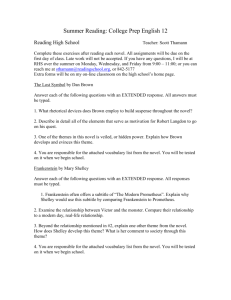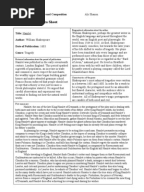(To be used for BOTH 1984 and Frankenstein)Name: Nina Perez-Dubson Major Works Data Sheet Major Works Data Sheet Characters (.6 minimum)Name Role in the story Significance Adjectives (3)1. Victor Frankenstein2. Elizabeth Lavenza5. Alphonse Frankenstein6. William Frankenstein 1. Protagonist and narrator at times. Creates the Monster.2. Victor Frankenstein’s. West Forsyth Major Works Data Sheet AP Literature and Composition Class Period: 1B Title of Work: Frankenstein Author: Mary. General Information: Record specific details below. Author (1) Mary Wollstonecraft Shelley Biographical information about the author (3) Mary Shelley was born on August 30, 1797, in London, England.
Born as Mary Wollstonecraft Godwin to William Godwin and Mary Wollstonecraft on August 30, 1789, Mary was the only child of her father and mother. Hardly more than a week after having Mary, Wollstonecraft died, leaving William to raise Mary and her half-sister, Fanny, whom William chose to adopt. When Mary was four, her father remarried but resentment was obvious between Mary and her stepmother. Later, following the suicides of both Mary’s older sister and Percy’s wife, the couple wedded.
Mary sank into depression following the death of three of her children and tolerating an unfaithful husband; Mary would never be entirely relieved of this depression. Historical background: Europe in the early 1800’s was not ideal, but it was evolving. Upper class men held the power in many governments, including England’s, while women were considered to be of a much lower social standing. Women held few rights and had few choices in life. Most of them just served the men in their lives including fathers, brothers, and husbands.

Society as a whole in Europe suffered from famine and typhus disease in the early 1800’s. Characteristics of the Genre: Gothicism: Gothicism focuses on historical, exotic, and remote settings. Also, violent plots are very common in Gothic literature. Plot – Structure Analysis: Consider the causal relationships, settings, and point of views. You may use the traditional Freytag’s triangle as a starting point (exposition, inciting force, rising action, climax, falling action, denouement). Then decide how the draw a graphic representation of the structure and its impact on other literary elements.
Describe the author’s style: Mary Shelley sticks to the Gothic Romanticism outline that was popular during this time by making a lot of her novel revolve around nature. Her style however, changes depending on who is narrating her novel. Whenever Victor, Captain Walton, or any human, education character of the book is talking, their speech is rather flowery and shows that they have been educated in the ways of the world. An example that demonstrates the style: The majority of Victor narrating the novel is a lot of his thought process.
Sure, he does talk, and interact some, however, there are some chapters in the book( such as chapter 4, 5, and 9) that are mostly just Victor’s thoughts and feelings. And these chapters aren’t simply syntax either, nor are they boringly depicted, rather they are filled with complex syntax and many descriptive words. Memorable Quotes Quote Significance 1. “William, Justine, and Henry – they all died by my hands. ” -Victor Frankenstein 2. “Seek happiness in tranquility and avoid ambition. ” -Victor Frankenstein 3. “The die is cast; I have consented to return if we are not destroyed.
Thus are my hopes blasted by cowardice and indecision; I come back ignorant and disappointed. It requires more philosophy than I possess to bear this injustice with patience. ” -Walton, page 190 4. “It was already one in the morning; the rain pattered dismally against the panes, and my candle was nearly burnt out, when, by the glimmer of the half-extinguished light, I saw the dull yellow eye of the creature open…” -Victor – In this quote, Victor Frankenstein is expressing deep grief and guilt. He is convinced that he is the root cause of all of their deaths.
This feeling explains why he chooses not to make the monster a companion and it also accounts for his “woe is me” attitude. In this quote, Victor is in a way giving a piece of advice. He knows he was too ambitious with the idea of scientifically creating a being and thinking that no repercussions would follow. He, in a way, wishes he had been content with just living his life in peace without his love of science. He knows that if he had ignored his ambitions, many of his loved ones would still be alive and he wouldn’t have to carry such a heavy burden of guilt on his shoulders.
Unlike Victor, Walton would rather live than be taken by the dangers of exploration. This quote is significant because it tells of the moment that Frankenstein’s troubles began. From this moment, when the monster comes to life, to the end of the novel, Victor is plagued by the horrors that the monster inflicts upon him. Had Victor not created the creature, or had his ‘experiment’ failed, he would not have lost so many loved ones and endured all the troubles that came with it. Characters Name Role in the story Significance

Adjectives Victor Frankenstein Victor is the protagonist and primary narrator in the story. Victor is a bright student who becomes tormented by the creation of the monster. He is evidence of the danger of too much knowledge. Intelligent Ambitious Secretive Henry Clerval Henry is Victor’s childhood friend who stays with him for much of the novel. Clerval is able to bring Victor out of his depression when no one else can. After Clerval’s death Victor seems never to be truly happy again. Romantic Optimistic Cheerful Justine Moritz
Justine was adopted into the Frankenstein family and was wrongly accused of William’s death. Justine symbolizes justice in the novel. She was wrongly accused and convicted of murdering William, thus symbolizing the lack of justice for the creature, the real murderer. Gentle Kind Passive Elizabeth Lavenza Elizabeth is Victor’s adopted sister who is pledged to be married to him Elizabeth is Victor’s one hope of happiness. Throughout his depression Elizabeth sends letters that cheer Frankenstein. All happiness is lost though when Elizabeth is killed on their wedding night.
Beautiful Kind Loving The Cottagers Felix, Agatha, De Lacey, and Safie are foreign exiles living in a cottage in the woods. The Cottagers unknowingly teach the monster how to read and speak, but are frightened when they encounter him in the flesh. This encounter leads the monster to vow revenge on all humankind. Intelligent Familial Accepting The Creature The Creature is Victor’s experiment to see if he could create life but later turns out to be more trouble than good. The Creature is the source of Victor’s agony through the novel.
Major Works Data Sheet For Frankenstein
The Creature murders several of Victor’s closest friends and relatives, causing Victor to be overridden with guilt. Cunning Hideous Loathsome Alphonse Frankenstein Alphonse is Victor’s father. Alphonse is a source of support for Victor in times of need, pointing Victor back to his family and Elizabeth. Since he does not know about the monster he is often not able to correctly determine the cause of Victor’s unhappiness, which leads Victor to more guilt at keeping a secret from his father. Strong-Willed Supportive Caring
Major Works Data Sheet Frankenstein
Major Works Data Sheet
Advanced Placement Literature and Composition
Title: Brave New World
Author: Aldous Huxley
Date of Publication: 1932
Genre: Dystopian Literature
Biographical Information about the Author:
Aldous Huxley was a British writer born in Surrey, England on July 26, 1894. He studied science at Eton, but a problem with his eyes left him partially blind and he had to leave after three years. When it eventually improved he attended Oxford, receiving a degree in English Literature. Over the course of his life he wrote many books of all which ranged from topics of drugs and sex to religion and politics. In 1945, Huxley began experimenting with drugs,…show more content…
Modernism, trailing after Realism, is a style that follows the mantra “Make it new!” It challenges previous styles, focusing less on spirituality and more on science and technology, becoming apathetic and less optimistic. Narrative style is a writing style that is presents all events in chronological order, and has a tendency to change focus going from one setting to another.
Provide an example that demonstrates the style:
“ ‘Or the Caste System. Constantly proposed, constantly rejected. There was something called democracy. As though men were more than physic-chemically equal.’
‘Well, all I can say is that I’m going to accept his invitation.’
Bernard hated them, hated them. But they were two, they were large, they were strong. ~ ~ ~ Memorable Quotes ~ ~ ~ ~
Quotes
“‘And that,’ put in the Director sententiously, ‘that is the secret of happiness and virtue – liking what you’ve got to do. All conditioning aims at that: making people like their inescapable social destiny.’” Ch. 1 pg. 16
“But I don’t want comfort. I want God, I want poetry, I want real danger, I want freedom, I want goodness. I want sin.”
“God in the safe and Ford on the shelves.”
Significance of each Quote:
The Director is explaining the reasoning being the class system of their society. He says as long as people are happy with their life, then society can function without problems. He believes